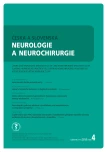Frey’s Syndrome (Auriculotemporal Syndrome) after Parotidectomy and its Prevention
Authors:
B. Gál 1; Z. Kadaňka Jr 2; T. Hložková 1; J. Hanák 1; J. Hložek 1
Authors‘ workplace:
Klinika otorinolaryngologie a chirurgie hlavy a krku LF MU a FN u sv. Anny v Brně
1; Neurologická klinika LF MU a FN Brno
2
Published in:
Cesk Slov Neurol N 2015; 78/111(4): 463-467
Category:
Short Communication
Overview
Background:
Frey´s syndrome (auricotemporal syndrome) is frequent sequelae of parotid gland surgery caused by inappropriate regrowth of parasympathetic fibres of the auriculotemporal nerve into sweat glands of the skin. Typically, the syndrome is characterized by sweating, erythema and flushing of the skin overlying the parotid region, especially in response to taste stimuli. Placement of an interpositional barrier between the skin and the parotid gland can prevent these complications.
Aim:
The purpose of this study was to evaluate the incidence of Frey´s syndrome and the impact of using sternocleidomastoid muscle (SCM) flap on this syndrome.
Material and methods:
In a retrospective study, a series of 167 patients who underwent partial or total parotidectomy between January 2007 and December 2011 were divided into two groups. One group had an SCM flap reconstruction (n = 42), and the other group did not (n = 125). A subjective clinical evaluation, a questionnaire and the objective Minor´s test were used to diagnose the syndrome post-surgery.
Results:
The overall incidence of Frey´s syndrome was 15% (25/167 patients), 16% (22/125) in the non-SCM flap group and 7% (3/42) in the SCM flap group, respectively. There was a statistically significant difference between the two groups according to the Fisher´s frequency exact test (p < 0.05).
Conclusion:
The SCM flap, used as an interposing barrier between the overlying skin and the parotid bed following parotidectomy, is a simple, fast and efficient method for preventing Frey´s syndrome following parotidectomy.
Key words:
Frey´s syndrome – auriculotemporal syndrome – sternocleidomastoid muscle flap – parotidectomy
The authors declare they have no potential conflicts of interest concerning drugs, products, or services used in the study.
The Editorial Board declares that the manuscript met the ICMJE “uniform requirements” for biomedical papers.
Sources
1. Stárek I, Černý L, Simpson RW (eds). Choroby slinných žláz. Praha: Grada Publishing 2000.
2. Gál B, Moltašová J. Chirurgická léčba benigních tumorů příušní žlázy: výsledky retrospektivní studie. In: Edukační sborník. XXXVI. brněnské onkologické dny a XXVI. konference pro sestry a laboranty. Brno, 19.– 21. dubna 2012: 162– 164.
3. Drummond PD. Mechanism of gustatory flushing in Frey’s syndrome. Clin Auton Res 2002; 12(3): 144– 146.
4. Curry JM, King N, Reiter D, Fisher K, Heffelfinger RN, Pribitkin EA. Meta‑analysis of surgical techniques for preventing parotidectomy sequelae. Arch Facial Plast Surg 2009; 11(5): 327– 331. doi: 10.1001/ archfacial.2009.62.
5. Cesteleyn L, Helman J, King S, Van de Vyvere G. Temporoparietal fascia flaps and superficial musculoaponeurotic system plication in parotid surgery reduces Frey‘s syndrome. J Oral Maxillofac Surg 2002; 60(11): 1284– 1297.
6. Taylor SM, Yoo J, Matthews TW, Lampe HB, Trites JR. Frey syndrome and parotidectomy flaps: a retrospective cohort study. Otolaryngol Head Neck Surg 2000; 122(2): 201– 203.
7. Filho WQ, Dedivitis RA, Rapoport A, Guimarães AV. Sternocleidomastoid muscle flap preventing Frey syndrome following parotidectomy. World J Surg 2004; 28(4): 361– 364.
8. Tuncel A, Karaman M, Sheidaei S, Tatlıpınar A, Esen E. A comparison of incidence of Frey‘s syndrome diagnosed based on clinical signs and Minor‘s test after parotis surgery. Kulak Burun Bogaz Ihtis Derg 2012; 22(4): 200– 206. doi: 10.5606/ kbbihtisas.2012.039.
9. Singleton GT, Cassisi NJ. Frey’s syndrome: incidence related to skin flap thickness in parotidectomy. Laryngoscope 1980; 90(10): 1636– 1639.
10. Linder TE, Huber A, Schmid S. Frey’s syndrome after parotidectomy: a retrospective and prospective analysis. Laryngoscope 1997; 107(11): 1496– 1501.
11. Athavale SM, Phillips S, Mangus B, Datta J, Sinard RJ, Netterville JL et al. Complications of alloderm and dermamatrix for parotidectomy reconstruction. Head Neck 2012; 34(1): 88– 93. doi: 10.1002/ hed.21684.
12. Bianchi B, Ferri A, Ferrari S, Copelli C, Sesenna E. Improving esthetic results in benign parotid surgery: statistical evaluation of facelift approach, sternocleidomastoid flap, and superficial musculoaponeurotic system flap application. J Oral Maxillofac Surg 2011; 69(4): 1235– 1241. doi: 10.1016/ j.joms.2010.03.005.
13. Blumenfeld RJ, Friedman JE. Intratympanic surgical treatment of Frey’s syndrome. Arch Otolaryngol 1967; 86(1): 2– 7.
14. Smith RO, Hemenway WM, Stevens KM, Ratzer ER. Jacobson’s neurectomy for Frey’s syndrome. Am J Surg 1970; 120(4): 478– 481.
15. Hartl DM, Julieron M, LeRidant AM, Janot F, Marandas P, Travagliet JP. Botulinum toxin A for quality of life improvement in post‑parotidectomy gustatory sweating (Frey’s syndrome). J Laryngol Otol 2008; 122(10): 1100– 1104. doi: 10.1017/ S0022215108001771.
16. Lenert R, Němeček O, Komínek P. Syndrom Freyové po parotidektomii – léčba roztokem chloridu hlinitého. Otorinolaryng a Foniat (Prague) 2002; 51(1): 41– 46.
17. Asal K, Köybasioglu A, Inal E, Ural A, Uslu SS, Ceylan Aet al. Sternocleidomastoid muscle flap reconstruction during parotidectomy to prevent Frey‘s syndrome and facial contour deformity. Ear Nose Throat J 2005; 84(3): 173– 176.
18. Sanabria A, Kowalski LP, Bradley PJ, Hartl DM, Bradford CR, de Bree R et al. Sternocleidomastoid muscle flap in preventing Frey‘s syndrome after parotidectomy: a systematic review. Head Neck 2012; 34(4): 589– 598. doi: 10.1002/ hed.21722.
19. Gooden EA, Gullane PJ, Irish J, Katz M, Carroll C. Role of the sternocleidomastoid muscle flap preventing Frey‘s syndrome and maintaining facial contour following superficial parotidectomy. J Otolaryngol 2001; 30(2): 98– 101.
Labels
Paediatric neurology Neurosurgery NeurologyArticle was published in
Czech and Slovak Neurology and Neurosurgery

2015 Issue 4
Most read in this issue
- Therapy of Pudendal Neuralgia – Five Years of Experience
- The Contribution of Magnetic Resonance Imaging to the Diagnosis of Epilepsy
- Experimental Treatment of Spinal Cord Injuries
- TLIF Technique for Treatment of Foraminal Lumbar Disc Herniation in Isthmic Spondylolisthesis
